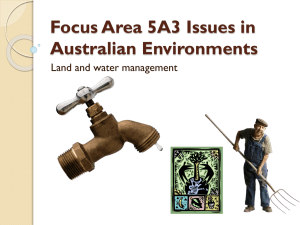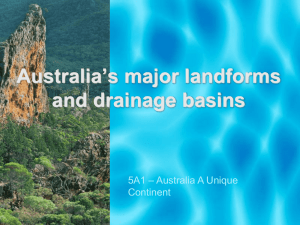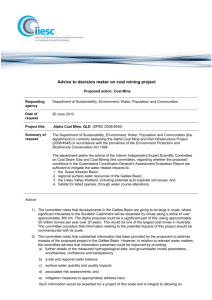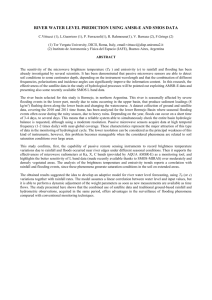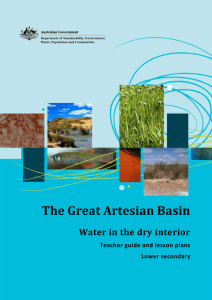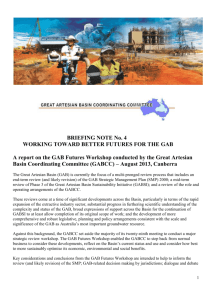gab__md_answers - Study Is My Buddy 2015
advertisement
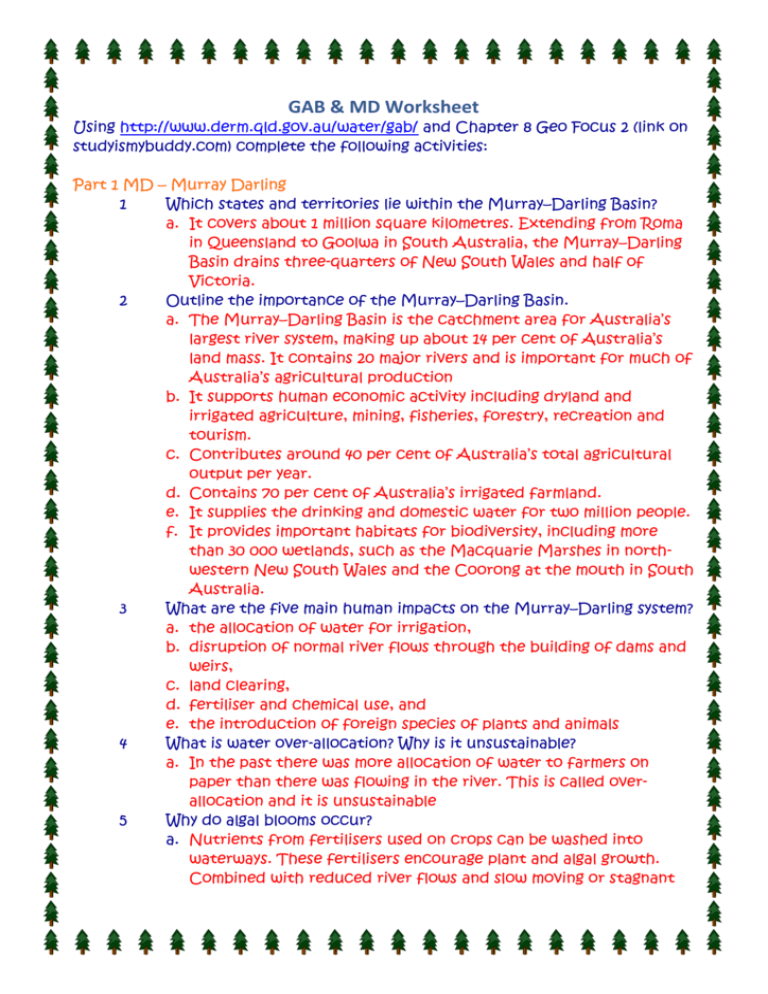
GAB & MD Worksheet Using http://www.derm.qld.gov.au/water/gab/ and Chapter 8 Geo Focus 2 (link on studyismybuddy.com) complete the following activities: Part 1 MD – Murray Darling 1 Which states and territories lie within the Murray–Darling Basin? a. It covers about 1 million square kilometres. Extending from Roma in Queensland to Goolwa in South Australia, the Murray–Darling Basin drains three-quarters of New South Wales and half of Victoria. 2 Outline the importance of the Murray–Darling Basin. a. The Murray–Darling Basin is the catchment area for Australia’s largest river system, making up about 14 per cent of Australia’s land mass. It contains 20 major rivers and is important for much of Australia’s agricultural production b. It supports human economic activity including dryland and irrigated agriculture, mining, fisheries, forestry, recreation and tourism. c. Contributes around 40 per cent of Australia’s total agricultural output per year. d. Contains 70 per cent of Australia’s irrigated farmland. e. It supplies the drinking and domestic water for two million people. f. It provides important habitats for biodiversity, including more than 30 000 wetlands, such as the Macquarie Marshes in northwestern New South Wales and the Coorong at the mouth in South Australia. 3 What are the five main human impacts on the Murray–Darling system? a. the allocation of water for irrigation, b. disruption of normal river flows through the building of dams and weirs, c. land clearing, d. fertiliser and chemical use, and e. the introduction of foreign species of plants and animals 4 What is water over-allocation? Why is it unsustainable? a. In the past there was more allocation of water to farmers on paper than there was flowing in the river. This is called overallocation and it is unsustainable 5 Why do algal blooms occur? a. Nutrients from fertilisers used on crops can be washed into waterways. These fertilisers encourage plant and algal growth. Combined with reduced river flows and slow moving or stagnant oober Pedy. With an area of metres the basin underlies he Australian continent. (See clayey sands were laid down by floodplains and lakes. This process produced a profile of alternating layers. As rivers eroded the steeper slopes, the land began to flatten, and deposition in lakes and large floodplains ume of water that is estimated became more dominant. The sandy sediments water, algal blooms can form, which are poisonous to humans, tres. It is enough water to fill consolidated to form the permeable sandstone from mes. which the artesian water is now tapped and the clayey animals and fish. sediments became the impermeable layers. Thickness of 6 Why isthe cooperation onvaries salinity combined layers from necessary less than 100between metres on all the levels of the basinacross extremities over 3000 metres in the deeper government thetowhole Murray–Darling Basin? parts. (See Figure 2). a. In order to resolve disputes and to manage the catchment During theeffectively, Cretaceous period (about 100 million years resources as differing agricultural and environmental ago), down warping and high sea levels created a interests areover prevalant shallow sea much of inland Australia. This sea deposited mainly muddy sediments, which later consolidated, forming the rolling downs that can be seen Part 2 – GAB – Great today.Artesian Basin 1 2 3 How much water does the GAB contain? As the Cretaceous period ended, about 65 million years a. 64 900 million megalitres ago, uplift ended sedimentation in the region of the GAB. Further uplifting and erosion resulted in the exposure of How old is it? the permeable sandstones in the marginal areas of the a. About million years ago Basin.65 This occurred mainly along the western edge of the present day Great Dividing Rainfall began to Use diagram to illustrate whyRange. it flows infiltrate into the sandstones that led to the accumulation of the vast groundwater reserve. asin med s, the GAB was created by the at eventually formed able sandstone and d mudstones. The deposits pressions; the Carpentaria, s which together form the Figure 2—Generalised cross-section of the Great Artesian Basin Artesian water Artesian water is underground water confined and pressurised within a porous and permeable geological formation. Formations that store and transmit water are referred to as aquifers. When one of these aquifers is tapped by a bore, artesian water may flow naturally to the surface. The Great Artesian Basin 4 The Great Artesian Basin (GAB) is one of the largest At the end of the Triassic period artesian groundwater basins in the world. It extends these basins occurred and erosi 2400 kilometres (km) from Cape York in the north to sedimentation. Throughout the p Where Dubbo does it flow? in the south. At its widest it is 1800 km from the was deposited by streams and r Darling Downs west of Coober Pedy. WithCape an area of in the clayey sands a. It extends 2400tokilometres (km) from York north towere laid down by over 1.7 million square kilometres the basin underlies This process produced a profile Dubbo in the south. At its widest it is 1800 km from the Darling approximately one-fifth of the Australian continent. (See rivers eroded the steeper slo Downs to1).west of Coober Pedy. With an area of overAs1.7 million Figure flatten, and deposition in lakes a square kilometres the volume basin underlies one-fifth ofdominant. The sa The GAB stores a huge of water that approximately is estimated became more be 64 900 million megalitres. It is enough water to fill consolidated to form the permea the to Australian continent Sydney Harbour 130 000 times. which the artesian water is now sediments became the imperme the combined layers varies from the basin extremities to over 300 parts. (See Figure 2). During the Cretaceous period (a ago), down warping and high se shallow sea over much of inland deposited mainly muddy sedime consolidated, forming the rolling today. As the Cretaceous period ended ago, uplift ended sedimentation Further uplifting and erosion res the permeable sandstones in the Basin. This occurred mainly alon the present day Great Dividing R infiltrate into the sandstones tha of the vast groundwater reserve. Figure 1—The Great Artesian Basin How the basin was formed 5 many managed? millions of years, the GAB was created by the How is Over it being Figure 2—Generalised cross-section deposition of sediments that eventually formed a. A collaborative strategic management plan is used by alternating layers15ofyear permeable sandstone and Artesian water Queensland, South South Australia, Northern impermeableNew siltstones and Wales, mudstones. The deposits Artesian water is underground w occurredand in three depressions; thegovernments Carpentaria, Territory themajor Commonwealth to achieve pressurised within a porous and Eromanga and Surat basins which together form the sustainability of the basin and its resources. The Great Artesian formation. Formations that store GAB. referred to Basin Coordinating Committee (GABCC) is responsible for as aquifers. When on tapped by a bore, artesian water coordinating management of the GAB between the jurisdictions surface. involved. Part 3 - General http://www.anbg.gov.au/aust-veg/seasonal-rainfall.html Australias seasons are: Summer: December to February Autumn: March to May Winter: June to August Spring: September to November Wet: December to March Dry: April to November 1. Find maps that show Australia’s average annual rainfall and summer and winter rainfall patterns. http://www.bom.gov.au/jsp/ncc/climate_averages/rainfall/index.jsp 2. What parts of Australia receive the highest amounts of rainfall? Broome 3. What parts of Australia receive the least rainfall? http://www.bom.gov.au/jsp/ncc/climate_averages/raindays/index.jsp 4. Describe and explain the pattern of Australia’s summer rainfall. It is region dependent - In the north there are tropical regions with high temperatures and high humidity and distinct wet and dry seasons. In the centre of the country are dry, desert regions with high daytime temperatures and low amounts of rain. In the south are the temperate regions with moderate rainfall and temperatures ranging from hot to cold. The tropical regions of Australia are in the north of the country. They include the central and northern parts of the Northern Territory and Queensland, and the northern parts of Western Australia. The weather in the Australian tropics has two very different seasons: the wet season and the dry season. The wet season lasts about six months in summer and spring, between December and March. It is hotter than the dry season, with temperatures between 30 and 50 degrees Celsius. This is because of the high humidity during the wet, which is caused by large amounts of water in the air. During the wet there is a lot of rain, which frequently causes flooding. The dry season lasts about six months in autumn and winter, usually between May and October. Temperatures are lower and the skies are generally clearer during the dry. The average temperature is around 20 degrees Celsius. http://australia.gov.au/about-australia/australian-story/austn-weather-andthe-seasons 5. Describe the pattern of Australia’s winter rainfall. Region dependent – the temperate areas receive more rain during the winter periods and the tropical regions receive the majority of their rain during the rainy season 6. What parts of Australia receive winter and summer dominant rainfall? Winter = temperate / dry Summer = tropical
